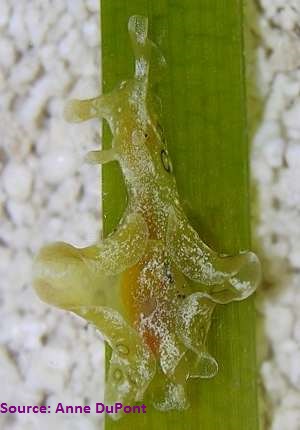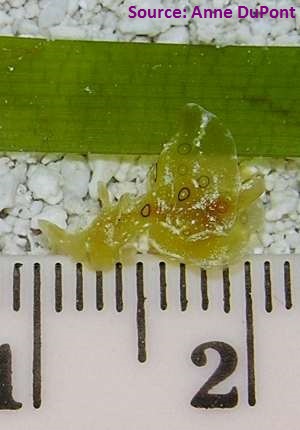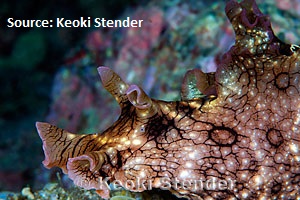
Reproduction
Aplysia dactylomela
lives a sexual reproductive life like many organisms; however in a
method peculiar to the average person,
A. dactylomela is
hermaphroditic in nature. The specific sexual life style is called
simultaneous hermaphroditic which means that one organism during its
life can fertilize the eggs of another organism thus acting as the
male meanwhile producing unfertilized eggs as a female.
.jpg) Oddly,
multiple organisms are able to form chains during copulation where
they are simultaneously providing sperm to one organism while
receiving sperm to fertilize their eggs from other organisms!
(Encyclopedia of Life 2008).
It may seem odd but the penis of A.
dactylomela is located on its head with an opening in between
the rhinophores and cephalic tentacles on the right side of the head
(Klussman-Klob 2004). During mating, the penis extends out of the
opening and connects to the vagina, located between the parapodia
within the mantle cavity, of the organism in front of it (Sea
Slug Forum 2000). As a means of reproduction, these sea
slugs attract mates with the aid of pheromones, specifically
attractin, which draws mates
Oddly,
multiple organisms are able to form chains during copulation where
they are simultaneously providing sperm to one organism while
receiving sperm to fertilize their eggs from other organisms!
(Encyclopedia of Life 2008).
It may seem odd but the penis of A.
dactylomela is located on its head with an opening in between
the rhinophores and cephalic tentacles on the right side of the head
(Klussman-Klob 2004). During mating, the penis extends out of the
opening and connects to the vagina, located between the parapodia
within the mantle cavity, of the organism in front of it (Sea
Slug Forum 2000). As a means of reproduction, these sea
slugs attract mates with the aid of pheromones, specifically
attractin, which draws mates  al.
2010).
al.
2010).
Unfortunately, studies have shown that the rise in ocean temperatures may interfere with the ability of A. dactylomela to communicate successfully through the use of these pheromones as they have been observed to more rapidly denigrate in warmer environments (Cummins et al. 2010).
Through their
usage of sexual chemicals and hermaphroditic biology, the average
sea hare is able to produce as many as 67 million offspring during
their year-round reproductive life: usually beginning around two
months of age an d continuing to the extent of their life at about
10-11 mon
d continuing to the extent of their life at about
10-11 mon
Up next: Uncover the intriguing interactions of the spotted sea hare
